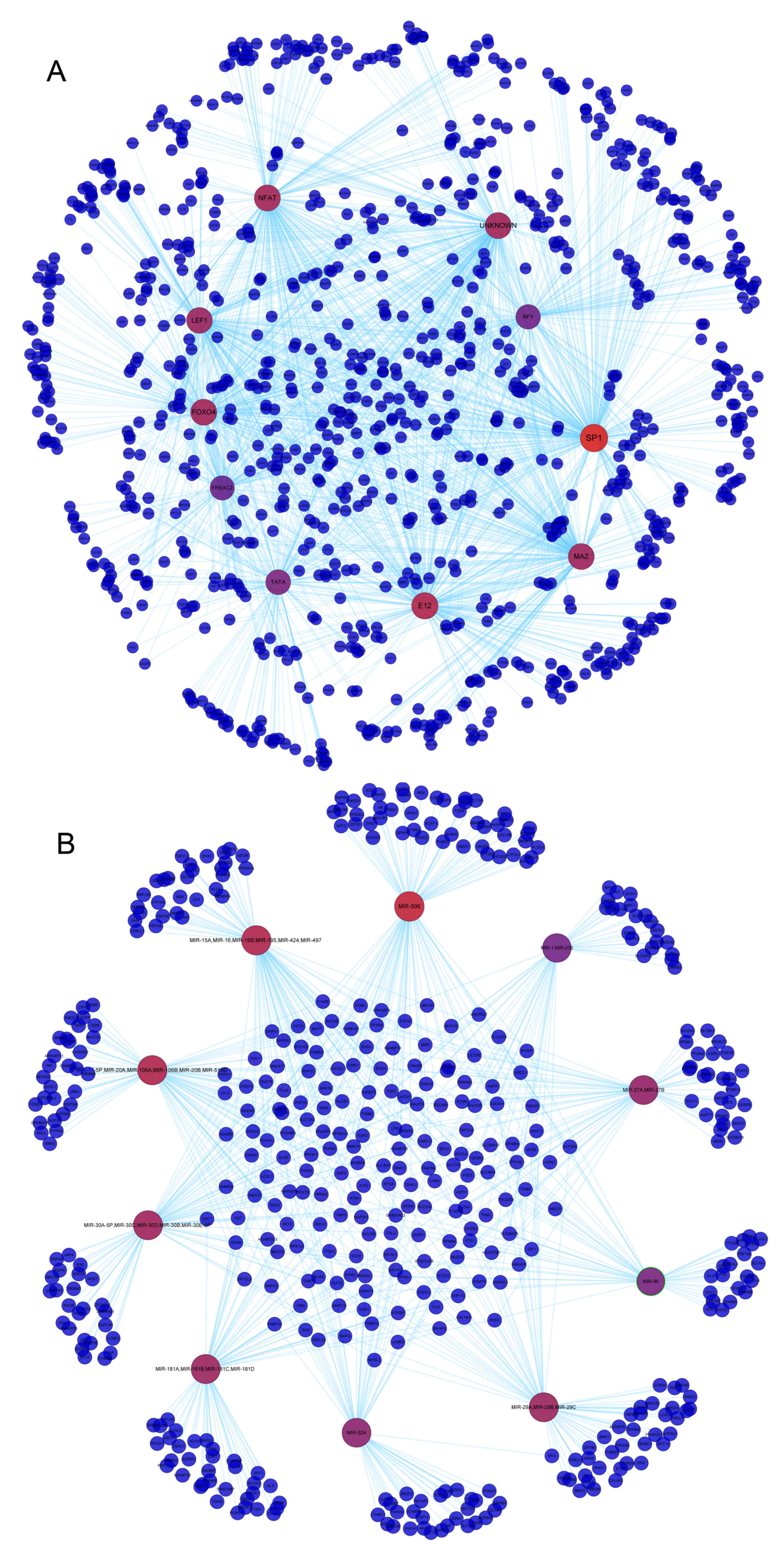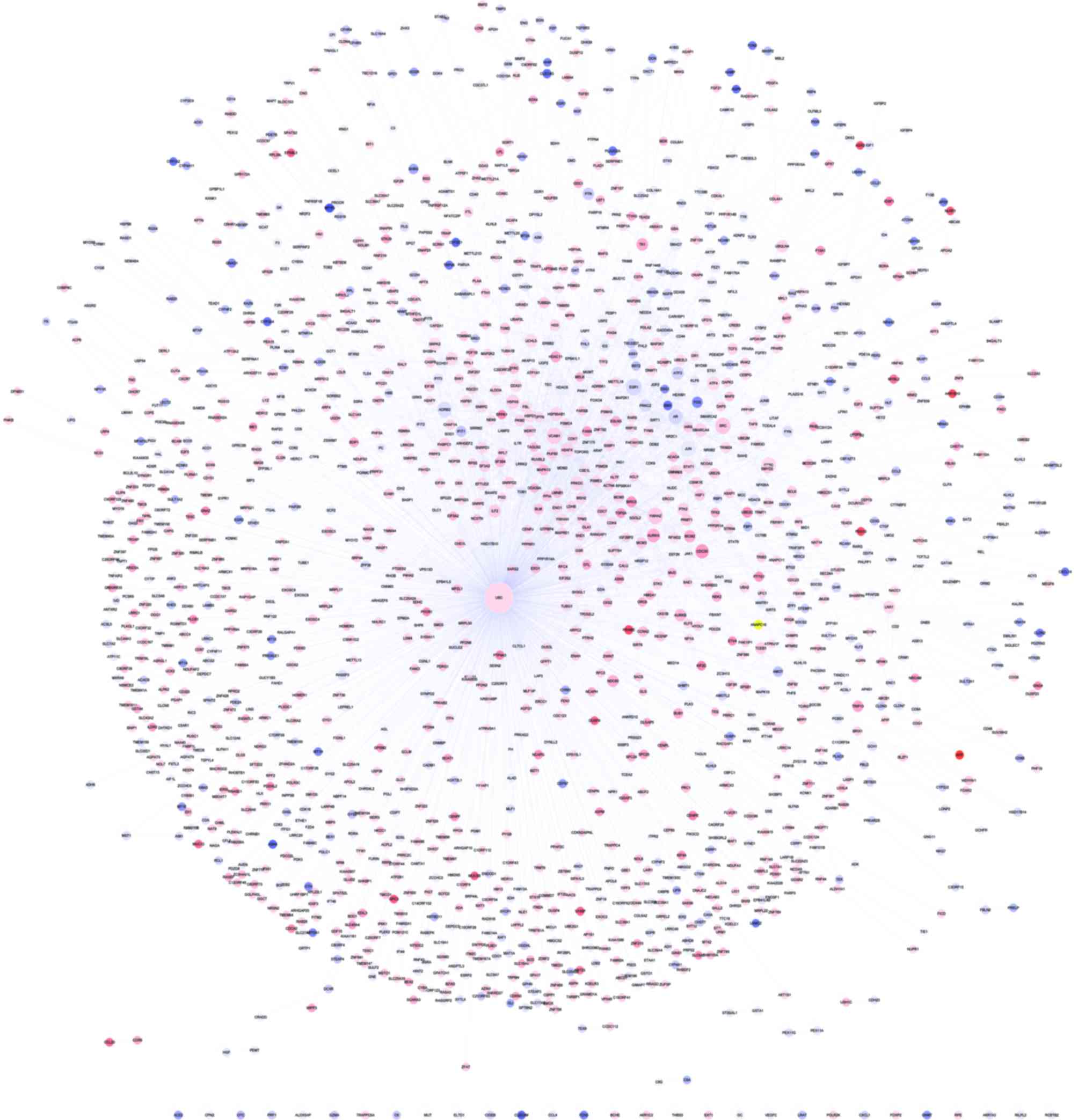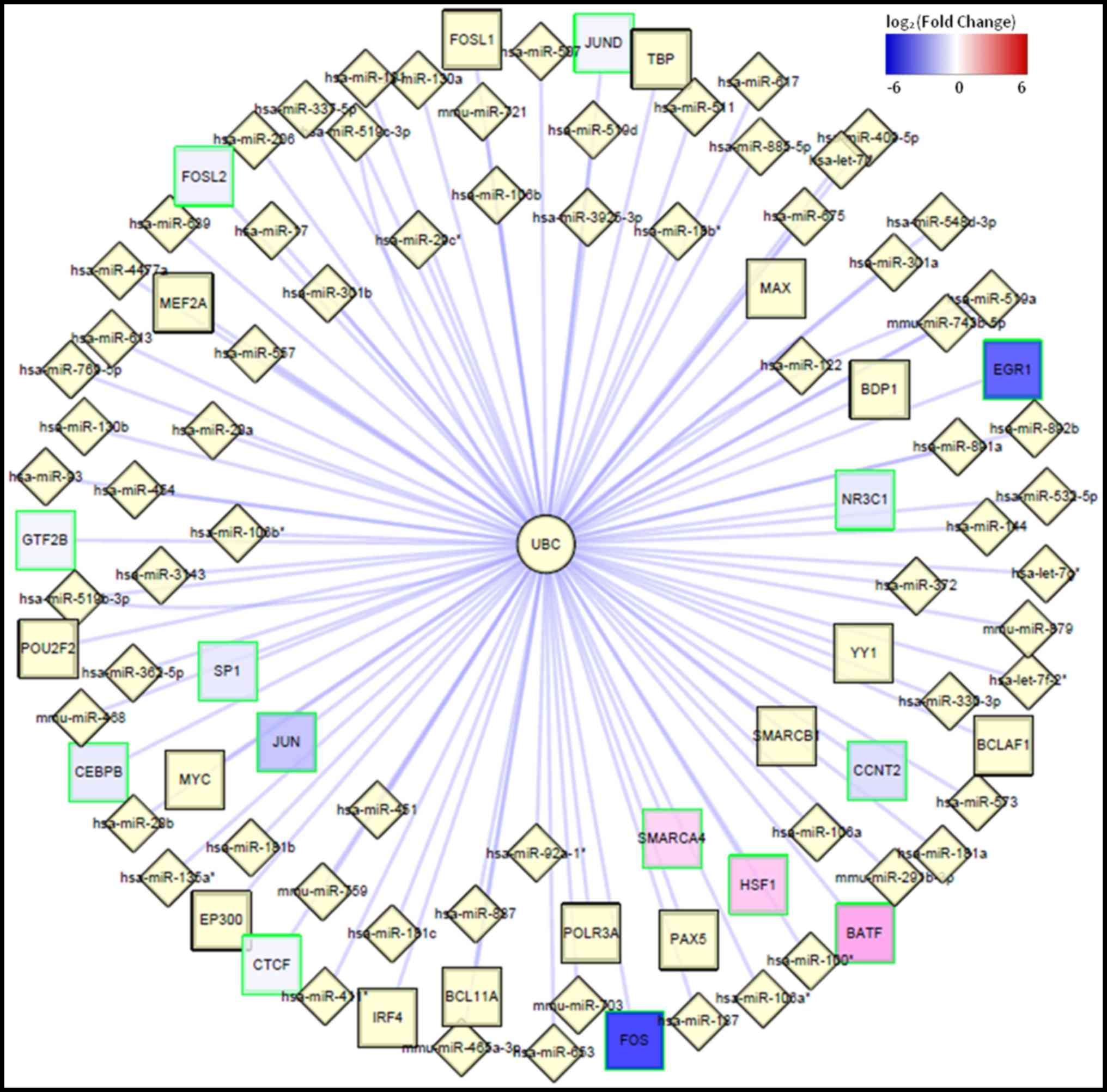|
1
|
Butt Z, Mallick R, Mulcahy MF, Benson AB,
Cella D and Kaiser K: Pain and other symptoms in patients with
hepatocellular carcinoma (HCC): A qualitative analysis. J. Clin
Oncol. 2013.
|
|
2
|
Hashimoto E and Tokushige K: Prevalence,
gender, ethnic variations, and prognosis of NASH. J Gastroenterol.
46 Suppl 1:63–69. 2011. View Article : Google Scholar : PubMed/NCBI
|
|
3
|
Simonetti J, Bulkow L, McMahon BJ, Homan
C, Snowball M, Negus S, Williams J and Livingston SE: Clearance of
hepatitis B surface antigen and risk of hepatocellular carcinoma in
a cohort chronically infected with hepatitis B virus. Hepatology.
51:1531–1537. 2010. View Article : Google Scholar : PubMed/NCBI
|
|
4
|
Schwartz M, Roayaie S and Uva P: Treatment
of HCC in patients awaiting liver transplantation. Am J Transplant.
7:1875–1881. 2007. View Article : Google Scholar : PubMed/NCBI
|
|
5
|
Huang Q, Lin B, Liu H, Ma X, Mo F, Yu W,
Li L, Li H, Tian T, Wu D, et al: RNA-Seq analyses generate
comprehensive transcriptomic landscape and reveal complex
transcript patterns in hepatocellular carcinoma. PLoS One.
6:e261682011. View Article : Google Scholar : PubMed/NCBI
|
|
6
|
Wong CM, Ng YL, Lee JM, Wong CC, Cheung
OF, Chan CY, Tung EK, Ching YP and Ng IO: Tissue factor pathway
inhibitor-2 as a frequently silenced tumor suppressor gene in
hepatocellular carcinoma. Hepatology. 45:1129–1138. 2007.
View Article : Google Scholar : PubMed/NCBI
|
|
7
|
Chen PJ, Yeh SH, Liu WH, Lin CC, Huang HC,
Chen CL, Chen DS and Chen PJ: Androgen pathway stimulates
MicroRNA-216a transcription to suppress the tumor suppressor in
lung cancer-1 gene in early hepatocarcinogenesis. Hepatology.
56:632–643. 2012. View Article : Google Scholar : PubMed/NCBI
|
|
8
|
Liu W, Li X, Chu ES, Go MY, Xu L, Zhao G,
Li L, Dai N, Si J, Tao Q, et al: Paired box gene 5 is a novel tumor
suppressor in hepatocellular carcinoma through interaction with p53
signaling pathway. Hepatology. 53:843–853. 2011. View Article : Google Scholar : PubMed/NCBI
|
|
9
|
Barrett T, Wilhite SE, Ledoux P,
Evangelista C, Kim IF, Tomashevsky M, Marshall KA, Phillippy KH,
Sherman PM, Holko M, et al: NCBI GEO: Archive for functional
genomics data sets-update. Nucleic Acids Res. 41(Database Issue):
D991–D995. 2013. View Article : Google Scholar : PubMed/NCBI
|
|
10
|
Auer PL and Doerge RW: Statistical design
and analysis of RNA sequencing data. Genetics. 185:405–416. 2010.
View Article : Google Scholar : PubMed/NCBI
|
|
11
|
Lin LI: A concordance correlation
coefficient to evaluate reproducibility. Biometrics. 45:255–268.
1989. View
Article : Google Scholar : PubMed/NCBI
|
|
12
|
Hansen P and Delattre M: Complete-link
cluster analysis by graph coloring. J American Statistical
Association. 73:397–403. 1978. View Article : Google Scholar
|
|
13
|
da W Huang, Sherman BT and Lempicki RA:
Systematic and integrative analysis of large gene lists using DAVID
bioinformatics resources. Nat Protoc. 4:44–57. 2008. View Article : Google Scholar
|
|
14
|
Goldberg DS and Roth FP: Assessing
experimentally derived interactions in a small world. Proc Natl
Acad Sci USA. 100:4372–4376. 2003; View Article : Google Scholar : PubMed/NCBI
|
|
15
|
Lam VW, Laurence JM, Johnston E, Hollands
MJ, Pleass HC and Richardson AJ: A systematic review of two-stage
hepatectomy in patients with initially unresectable colorectal
liver metastases. HPB. 15:483–491. 2013. View Article : Google Scholar : PubMed/NCBI
|
|
16
|
Ockner RK, Kaikaus RM and Bass NM:
Fatty-acid metabolism and the pathogenesis of hepatocellular
carcinoma: Review and hypothesis. Hepatology. 18:669–676. 1993.
View Article : Google Scholar : PubMed/NCBI
|
|
17
|
Cheng J, Imanishi H, Amuro Y and Hada T:
NS-398, a selective cyclooxygenase 2 inhibitor, inhibited cell
growth and induced cell cycle arrest in human hepatocellular
carcinoma cell lines. Int J Cancer. 99:755–761. 2002. View Article : Google Scholar : PubMed/NCBI
|
|
18
|
Zhou L, Wang Q, Yin P, Xing W, Wu Z, Chen
S, Lu X, Zhang Y, Lin X and Xu G: Serum metabolomics reveals the
deregulation of fatty acids metabolism in hepatocellular carcinoma
and chronic liver diseases. Anal Bioanal Chem. 403:203–213. 2012.
View Article : Google Scholar : PubMed/NCBI
|
|
19
|
Hochstrasser M: Ubiquitin, proteasomes,
and the regulation of intracellular protein degradation. Curr Opin
Cell Biol. 7:215–223. 1995. View Article : Google Scholar : PubMed/NCBI
|
|
20
|
Chan DW, Chan CY, Yam JW, Ching YP and Ng
IO: Prickle-1 negatively regulates Wnt/beta-catenin pathway by
promoting Dishevelled ubiquitination/degradation in liver cancer.
Gastroenterology. 131:1218–1227. 2006. View Article : Google Scholar : PubMed/NCBI
|
|
21
|
Hoeller D, Hecker CM and Dikic I:
Ubiquitin and ubiquitin-like proteins in cancer pathogenesis. Nat
Rev Cancer. 6:776–788. 2006. View
Article : Google Scholar : PubMed/NCBI
|
|
22
|
Bertrand MJ, Milutinovic S, Dickson KM, Ho
WC, Boudreault A, Durkin J, Gillard JW, Jaquith JB, Morris SJ and
Barker PA: cIAP1 and cIAP2 facilitate cancer cell survival by
functioning as E3 ligases that promote RIP1 ubiquitination. Mol
Cell. 30:689–700. 2008. View Article : Google Scholar : PubMed/NCBI
|
|
23
|
Sureban SM, Qu D and Houchen CW:
Epigenetic Variations of Stem Cell Markers in CancerEpigenetics and
Cancer. Springer; pp. 115–128. 2013, View Article : Google Scholar
|
|
24
|
Magan N, Szremska AP, Isaacs RJ and
Stowell KM: Modulation of DNA topoisomerase II alpha promoter
activity by members of the Sp (specificity protein) and NF-Y
(nuclear factor Y) families of transcription factors. Biochem J.
374:723–729. 2003. View Article : Google Scholar : PubMed/NCBI
|
|
25
|
Marin M, Karis A, Visser P, Grosveld F and
Philipsen S: Transcription factor Sp1 is essential for early
embryonic development but dispensable for cell growth and
differentiation. Cell. 89:619–628. 1997. View Article : Google Scholar : PubMed/NCBI
|
|
26
|
Wang YT, Chuang JY, Shen MR, Yang WB,
Chang WC and Hung JJ: Sumoylation of specificity protein 1 augments
its degradation by changing the localization and increasing the
specificity protein 1 proteolytic process. J Mol Biol. 380:869–885.
2008. View Article : Google Scholar : PubMed/NCBI
|
|
27
|
Bossis G, Malnou CE, Farras R,
Andermarcher E, Hipskind R, Rodriguez M, Schmidt D, Muller S,
Jariel-Encontre I and Piechaczyk M: Down-regulation of c-Fos/c-Jun
AP-1 dimer activity by sumoylation. Mol Cell Biol. 25:6964–6979.
2005. View Article : Google Scholar : PubMed/NCBI
|
|
28
|
Min L, Ji Y, Bakiri L, Qiu Z, Cen J, Chen
X, Chen L, Scheuch H, Zheng H, Qin L, et al: Liver cancer
initiation is controlled by AP-1 through SIRT6-dependent inhibition
of survivin. Nat Cell Biol. 14:1203–1211. 2012. View Article : Google Scholar : PubMed/NCBI
|
|
29
|
Wang Z, Xiang Q, Li D and Li S:
Correlation between gene expression and chromatin conformation of
c-fos and N-ras in human liver and hepatoma. Chin Med Sci J. 6:6–8.
1991.PubMed/NCBI
|
|
30
|
Wu C, Gong Y, Yuan J, Zhang W, Zhao G, Li
H, Sun A, Kai Hu, Zou Y and Ge J: microRNA-181a represses
ox-LDL-stimulated inflammatory response in dendritic cell by
targeting c-Fos. J Lipid Res. 53:2355–2363. 2012. View Article : Google Scholar : PubMed/NCBI
|
|
31
|
Wilson BG and Roberts CW: SWI/SNF
nucleosome remodellers and cancer. Nat Rev Cancer. 11:481–492.
2011. View
Article : Google Scholar : PubMed/NCBI
|
|
32
|
Medina PP, Romero OA, Kohno T, Montuenga
LM, Pio R, Yokota J and Sanchez-Cespedes M: Frequent
BRG1/SMARCA4-inactivating mutations in human lung cancer cell
lines. Hum Mutat. 29:617–622. 2008. View Article : Google Scholar : PubMed/NCBI
|
|
33
|
Ramos P, Karnezis AN, Hendricks WP, Wang
Y, Tembe W, Zismann VL, Legendre C, Liang WS, Russell ML, Craig DW,
et al: Loss of the tumor suppressor SMARCA4 in small cell carcinoma
of the ovary, hypercalcemic type (SCCOHT). Rare Dis. 2:e9671482014.
View Article : Google Scholar : PubMed/NCBI
|
|
34
|
Guichard C, Amaddeo G, Imbeaud S, Ladeiro
Y, Pelletier L, Maad IB, Calderaro J, Bioulac-Sage P, Letexier M,
Degos F, et al: Integrated analysis of somatic mutations and focal
copy-number changes identifies key genes and pathways in
hepatocellular carcinoma. Nat Genet. 44:694–698. 2012. View Article : Google Scholar : PubMed/NCBI
|












